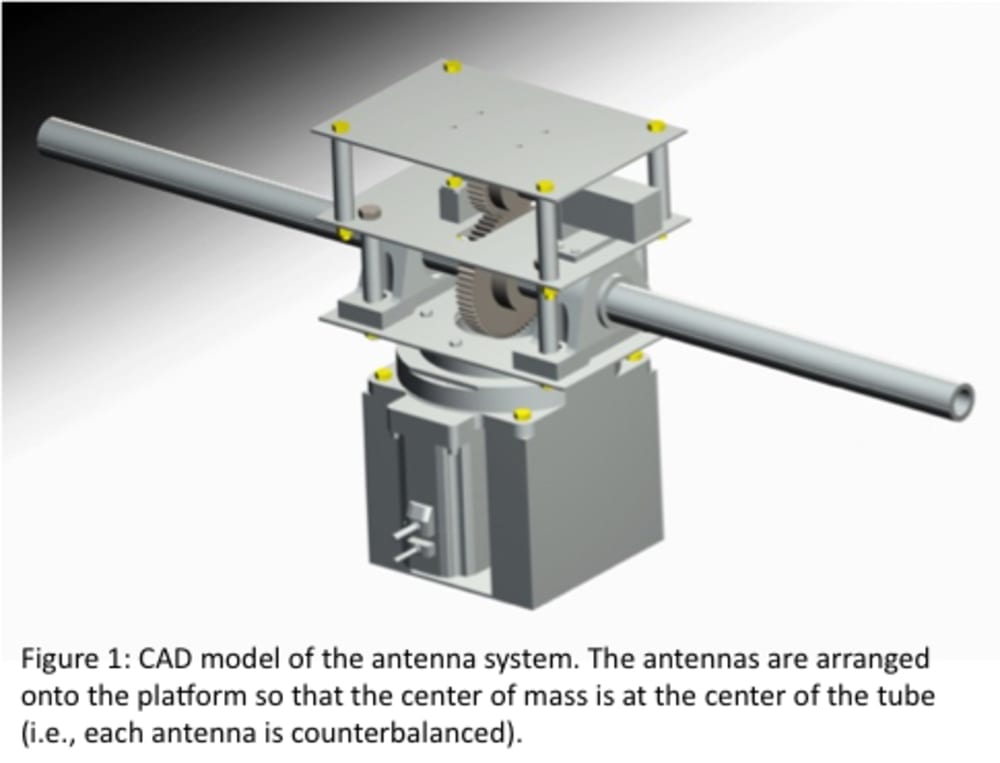We have designed an antenna-mounting platform capable of aiming four or more antennas of any type, effectively tracking an unmanned aerial vehicle (UAV) or other moving object carrying multiple radios operating at different frequencies. Our unique design is portable and can accommodate nearly 60 pounds of antennas and radios, limited in number only by the size of the mounting bar installed on the platform.
Our design fulfills an unmet need in the UAV market, integrating multiple capabilities onto one low-cost portable platform. Most low-cost antenna tracking platforms support only one antenna per unit, have limited rotational ability, and are relatively slow. Unlike existing high-performance platforms, which overcome these limitations while costing up to $100,000, our design uses less expensive motors to support smaller antennas and electrical slip rings instead of RF rotary joints. These features make our platform lightweight, cheap, and frequency-agnostic by design while keeping the price tag below $5,000.
BENEFITS:
Portable: Its lightweight components and small profile allow it to be carried by a single person.
Simple setup: Mounting an antenna is as simple as sliding a mounting piece and bolting on the antenna and its associated radio, without the need for load-balancing hardware.
Versatile: Up to 58 pounds of antennas from various manufacturers in any combination can be accommodated. The platform has no frequency-dependent components, so it can be used with any antenna.
Continuous rotation: Our platform runs all power and signals through electrical slip rings or fiber optic rotary joints, enabling continuous rotation about azimuth, without needing to “unwind” and lose telemetry connection with the object being tracked.
Low power: Small motors drawing low power rotate the antennas about azimuth and elevation.
Low cost: The overall system is estimated to cost less than $5,000--1/20th the cost of platforms with comparable capabilities.
APPLICATIONS:
--Law enforcement
--Surveillance
--Atmospheric and Earth science research
--Agriculture (e.g., crop spraying)
--Monitoring/Protecting animal species
--Marine communication (within line-of-sight)
--Tracking low-earth orbit satellites
--University research aircraft
--Tracking sounding rockets
--Tracking weather balloons
HOW IT WORKS:
A microcontroller interface drives the motors and receives antenna commands from the software. Customized user-interface software reads GPS-based data and user commands to control the tracking antenna. Powered by 120 VAC and updating its aiming position at a frequency of 30 Hz, the platform can move all of the antennas and other equipment simultaneously in continuous rotation in azimuth and over 180 degrees of rotation about the elevation axis, maintaining line-of-sight tracking.
Manufacturing requires only basic machining and soldering skills. Virtually all components are commercial-off-the-shelf parts. Only the mounting bracket is a custom-designed piece, which was made of plastic on the prototype but would be aluminum in production.
As Congress contemplates opening up the U.S. airspace for commercial use of UAVs, the market potential for this innovative antenna-mounting platform--which is perfect for use with small and miniature UAVs--will dramatically increase.
Like this entry?
-
About the Entrant
- Name:Kurt Sanner
- Type of entry:teamTeam members:Kurt Sanner
Evan Kaiser - Patent status:pending

